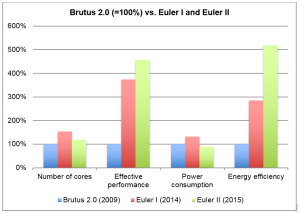Energy efficiency in high performance computing
The installation of the second phase of the Euler cluster (Euler II) is now complete.
As part of the acceptance procedure, the HPL benchmark was used to assess the cluster’s effective performance and energy consumption. HPL uses LINPACK, a linear algebra program, to calculate the LU decomposition of a very large matrix distributed across all the cluster’s compute nodes. In the present case the matrix contained 1’482’816 x 1’482’816 = 2’198’743’289’856 elements distributed over 320 nodes. HPL is widely popular in HPC because it pushes a cluster’s components — CPU, memory and high-speed network — to their limit. Additionally, HPL is so power-hungry that it constitutes an excellent test for the cluster’s power and cooling infrastructure. A typical HPL run takes several hours, and many runs are needed to get the best possible performance. If a cluster survives this kind of torture, one can safely say that it is ready for production.
Euler II successfully passed this test on February 11. It achieved a sustained performance of 237 TF (1 TF = 10^12 floating-point operations per second) using a maximum of 134 kW of electricity. By comparison, last year Euler I achieved 194 TF using 200 kW, whereas in 2009 Brutus 2.0 achieved 52 TF using 152 kW. As one can see in the graph below, Euler I and Euler II have brought not only big performance gains compared to their predecessor, but also dramatic improvements in terms of energy efficiency. This is quite remarkable, considering that in 2009 Brutus 2.0 was reportedly the most energy-efficient general-purpose supercomputer in the world!

erstellt am
in News


